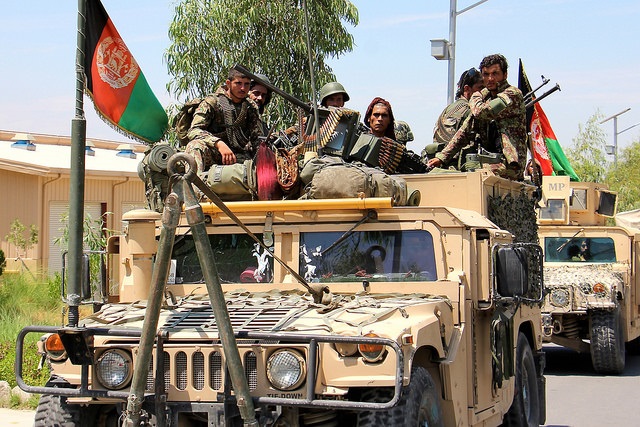In Afghanistan, the Glass is Still Better Seen as Half Full: A Response to Gary Owen
Editor's Note: In the latest entry in our ongoing dialogue on the future of Afghanistan, Stephen Watts and Sean Mann respond to Gary Owen's critique of their piece on the future of Afghanistan, arguing that although things may not be going "great" in Afghanistan, the picture is not quite as bleak as Owen makes it out to be.
***

Published by The Lawfare Institute
in Cooperation With

Editor's Note: In the latest entry in our ongoing dialogue on the future of Afghanistan, Stephen Watts and Sean Mann respond to Gary Owen's critique of their piece on the future of Afghanistan, arguing that although things may not be going "great" in Afghanistan, the picture is not quite as bleak as Owen makes it out to be.
***
On August 9, Gary Owen responded to an earlier post we had written about the ongoing war in Afghanistan, questioning several of our assessments about the current state of affairs in that country. Owen raised many important points, and we appreciate the opportunity to respond.
Although Owen’s piece was titled “Sorry, Folks—Things Are Not Actually Going So Great in Afghanistan,” we want to point out that we never claimed that things were going “great.” In fact, we acknowledged numerous problems and predicted that the war would continue for many years. We did not dwell on the bad news, since media reports and policy blogs are filled with such accounts (we went into somewhat greater depth about Afghanistan’s many weaknesses in a longer version of our argument, published in The Washington Quarterly).
But Afghanistan clearly remains one of the poorest and most fragile states in the world. Our central point was that the situation in Afghanistan is less bleak than is popularly portrayed in the media, less bleak than it was before the United States intervened, and less bleak than it would be if the United States precipitously withdrew the bulk of its remaining forces and assistance dollars. In fact, we seem to agree with Owen on these points, since his conclusion begins: “The reality is that that Afghanistan’s future, while grim, is still better than it was. There is cause for cautious optimism.”
Our disagreements with Owen center on three critical issues: (1) the quality and likely longevity of the current power-sharing arrangement between Afghanistan’s President Ashraf Ghani and Chief Executive Abdullah Abdullah; (2) the quality of the Afghan National Defense and Security Forces (ANDSF) and its ability to maintain reasonable levels of security in critical regions of Afghanistan; and (3) the incentives Pakistan faces in dealing with Afghanistan.
The quality and longevity of current power-sharing arrangements
Owen rightly points out that the current power-sharing arrangement between Ghani and Abdullah was the product of considerable U.S. diplomatic pressure. We should not be sanguine about the durability of this arrangement; all power-sharing arrangements are fragile, particularly in conditions of ongoing war. But the fact that U.S. diplomatic pressure was necessary to secure the current governance arrangements in Afghanistan does not mean that they are meaningless indicators of Afghanistan’s likely political trajectory.
Most power-sharing arrangements in conflict and post-conflict countries come about in large part through international pressure; Afghanistan is not unique in this respect. The real question, then, is how these governance arrangements have functioned, and here there are two grounds for optimism. First, it is important to note the quality of the officeholders. As our colleague Jonah Blank pointed out in Foreign Affairs, Ghani and Abdullah were likely the best two candidates in the field of contenders in Afghanistan’s last presidential election: “[B]efore this electoral season began, few observers would have guessed that the final showdown would be between a pair of level-headed pro-Western moderates rather than two foul, bloodstained warlords.” Either is clearly an upgrade over Afghanistan’s previous president, Hamid Karzai.
The fact that U.S. diplomatic pressure was necessary to secure the current governance arrangements in Afghanistan does not mean that they are meaningless indicators of Afghanistan’s likely political trajectory.
Second, the power-sharing arrangements have worked out better than nearly anyone predicted. The government has undertaken significant policy initiatives, including mending relations with Pakistan and supporting peace talks, without provoking schisms. While the process of filling cabinet positions—now nearly complete—has been contentious, this is business as usual in Afghanistan. Karzai’s experience forming a government after re-election in 2009 faced similar challenges and worse.
The mere fact that the United States’ diplomatic pressure was responsible for the power-sharing arrangement did not foreordain these relatively positive outcomes. The United States placed diplomatic pressure on Karzai for years, with much poorer results than it has seen from the Ghani-Abdullah arrangements. It has also used diplomatic pressure to try to make power-sharing mechanisms function in places like Bosnia and Iraq, also with frequently worse outcomes. Understood in context, the Ghani-Abdullah arrangements have thus far indeed been a relative success.
The quality of the Afghan National Defense and Security Forces (ANDSF)
We stand by our assessment that the ANDSF are passably capable and resilient, despite all the problems listed by Owen. This assessment is only possible now that the forces are largely standing on their own. This year, ANDSF casualties are up, which was to be expected with the removal of coalition combat and medical support. Attrition is a concern, but is in fact lower now than it was in either 2013 or 2014, and recruitment remains strong; overall, force levels have not declined. Moreover, it is not exactly clear what the recent trends in fighting portend—whether the Taliban can sustain this higher intensity indefinitely, or whether it and other anti-government forces are making an intensive push to test the new government’s resilience as the United States draws down. Although reliable numbers on insurgent deaths are hard to come by, the Taliban may also be experiencing a spike in fatalities, the sustainability of which is an open question.
Owen notes that more civilian casualties were attributed to the ANDSF (37 percent) than to the Taliban (32 percent) as a result of ground engagements this year. Much of this was driven by the ANDSF’s increasing reliance on artillery as a substitute for more precise coalition airpower. The trend is worrisome and rightly focuses attention on the ANDSF’s use of these weapons. Yet the comparison between the two sides looks quite different when considering civilians killed and injured in all conflict-related violence. Even including ground engagements, the ANDSF have been responsible for just 15 percent of all civilian casualties this year, compared to the 70 percent attributed to the Taliban and other insurgent groups.
Owen is absolutely correct in highlighting that detainee mistreatment in Afghanistan is a serious problem. Without intending to minimize the extent of the problem in any way, we do want to note that the UNAMA report Owen cites actually claims that one-third (35 percent) of detainees it interviewed experienced torture or ill-treatment, with the latter a serious, but less severe category of “cruel, inhuman, or degrading treatment.” Regardless of extent, efforts to reign in government abuses should remain a priority for Afghanistan’s international backers. Yet the persistence of torture in many developing countries, including in all of Afghanistan’s immediate neighbors, indicates that such abuses are neither exceptional nor easy to stamp out.
The evidence to date suggests that the ANDSF will be able to hold the major cities, highways, provincial capitals, and at least the great majority of districts, assuming continued outside financial support.
Another of Owen’s concerns, that militias will rise to fight the Taliban and then take over the security forces, is not new. Those Afghans who claim they could mobilize a militia with any national or even regional clout, such as Vice President Rashid Dostum, have threatened to do so for years, but have largely been content to bluster, fight over local turf, and seek formal government posts. Worryingly, this may be changing. Increasing militia involvment, particularly in the north, has the potential to spark wider ethnic conflict. Even an ascendant militia, however, would find wresting control of the security forces difficult, as the ANDSF—even the more elite units—are too diverse to serve as a coup force without first dissolving and reforming along factional lines.
So far, the ANDSF are weathering the shock of coalition withdrawal better than expected. The fighting this year is tough, and the Afghan government will likely find itself overstretched in its goal of maintaining control over all of the roughly 400 districts in the country. But the evidence to date suggests that the ANDSF will be able to hold the major cities, highways, provincial capitals, and at least the great majority of districts, assuming continued outside financial support.
The role of Pakistan
Finally, Owen argues that Pakistan is not worried about Afghanistan becoming a safe haven for insurgents attacking the Pakistani state; instead, he argues, there are more than enough safe havens already within Pakistan, and in any case, elements of the government of Pakistan are themselves complicit in harboring insurgents. While both of the latter points are true, neither causes Pakistan to be indifferent about the possibility of insurgents flowing from Afghanistan back into Pakistan.
There are a great many different insurgent and terrorist groups operating within Pakistan. Although the government of Pakistan (or parts of the government) harbors the Afghan Taliban and Haqqani insurgent network, it is actively fighting other groups. Particularly since the 2014 attack by the Tehrik-e Taliban Pakistan (TTP) in Peshawar that left over 140 people dead (most of them schoolchildren), Pakistan has adopted a much more aggressive approach to combating many of the insurgent groups operating in Pakistan. While the United States might like to see both more and better counterinsurgency activity from the government of Pakistan, it is clear that Pakistan sees that some of these militant groups pose a real threat and is seeking to deny them operating space within Pakistan itself. Yet members of the TTP, including its leader Mullah Fazlullah, have long found refuge in eastern Afghanistan. Under such circumstances, Islamabad does indeed have reasons to cooperate with Kabul—if not across the board, then at least in a number of areas of mutual interest.
In short, Gary Owen is not wrong to raise concerns about all three of these issues; they all pose real challenges to U.S. policy and are critical to achieving a minimally acceptable outcome in Afghanistan. But while things are certainly not “great” in Afghanistan, we also are not as discouraged by developments in these three areas as Owen is—and indeed see more reasons for hope than many had expected to see by this point in the transition from a large U.S. presence to a greatly reduced one.






